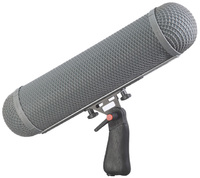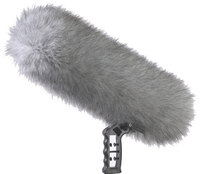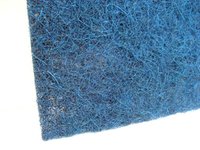 The basic blimp (the term "zeppelin" is actually a registered trademark of K-Tek) windscreen is an example of two-stage protection (see left). The outer mesh shell slows down the approaching air. Whatever air passes through the mesh is then further slowed down by the non-moving trapped air within the blimp screen itself.
The basic blimp (the term "zeppelin" is actually a registered trademark of K-Tek) windscreen is an example of two-stage protection (see left). The outer mesh shell slows down the approaching air. Whatever air passes through the mesh is then further slowed down by the non-moving trapped air within the blimp screen itself.
The effectiveness of a blimp windscreen can be improved by adding additional barriers between the onrushing air and the mic element; this is known as multi-stage wind protection.
For instance, using a thin foam windscreen over the microphone inside of the blimp provides a major increase of wind protection. Make sure to leave plenty of airspace between the foam and the inside of the blimp, or else you will defeat the purpose of multi-stage wind reduction. That layer of non-moving air is vital.
 The other and more common way of improving a blimp windscreen is to use a fabric or synthetic fur windsock over the outer shell. The use of a plush fur is very effective because the hair tends to disperse the oncoming wind, thus reducing velocity but also eliminating the acoustic noise generated by high wind physically striking the outer shell of the blimp.
The other and more common way of improving a blimp windscreen is to use a fabric or synthetic fur windsock over the outer shell. The use of a plush fur is very effective because the hair tends to disperse the oncoming wind, thus reducing velocity but also eliminating the acoustic noise generated by high wind physically striking the outer shell of the blimp.
If the budget is tight, fake fur windsocks can be fairly easily sewn together by anyone handy with a sewing machine, such as a Costumer or Wardrobe person.
Spraying some water repellent onto your windsock will help provide protection against rain. Heavy rain or firehoses may also call for a protective latex condom (dry, non-lubed) over the microphone itself to help safeguard the fragile electronics.
 Hollywood sound mixers often manufacture "rain hats" made from rubberized "hogs hair" (see left) to slip over the blimps. The hogs hair is a rubberized, thistle type material that disperses the rain drops upon impact, thus eliminating the pitter patter noise that the water would otherwise make when it struck the windscreen. The same effect can also be found on the RAINMAN blimp cover.
Hollywood sound mixers often manufacture "rain hats" made from rubberized "hogs hair" (see left) to slip over the blimps. The hogs hair is a rubberized, thistle type material that disperses the rain drops upon impact, thus eliminating the pitter patter noise that the water would otherwise make when it struck the windscreen. The same effect can also be found on the RAINMAN blimp cover.
An important guideline to follow when using windscreens is to only use as much barrier protection as is needed, but never less than what is needed. The more stuff you surround your mic with, the more you will interfere with the frequency response and even pattern of your mic. On the other hand, not having enough wind protection will lead to contact wind noise, which is not fixable in the mix.
Outdoors, with all of the ambient noise, the loss of some subtle frequency response is negligible and a small price to pay compared to the havoc that raw wind could have on the diaphragm of the mic capsule.
When the wind is blowing up a storm, your actors will also be shouting their dialogue, so that some loss of frequency response is unlikely to affect the (lack of) subtlety of this forced dialogue anyway
Indoors, however, we may be more likely to notice the loss of that near-perfect frequency response that our premium shotgun mics have the potential to deliver. So try to avoid using heavy windsocks and blimps on your indoor stuff.
In conclusion, remember that sensitive shotgun mics should always be used with a shockmount and some form of wind protection.
Every so often, we witness examples of shotgun mics being used without any wind protection whatsoever. That is just plain wrong! Remember, there is always some sort of moving wind, even indoors, whether it is caused by the motion of the boompole or the ventilation system. The trick is, utilize the appropriate degree of wind protection based on your budget, environment, and sensitivity of microphone.
Indoors, a simple foam windscreen will suffice. If the mic offers a built-in low cut filter, engage it. Except for music and special sound effects, leaving the low-cut filter engaged should be your default setting.
Outdoors, in an urban environment with only slight to moderate gusts of wind, a fur covered windscreen that slides over the mic should be fine for most (battery powered) ENG type mics, and sometimes for full condenser short shotguns.
Long shotguns, especially the super sensitive full condenser types, should routinely be housed in a full blimp windsreen covered with some sort of wool or furry windsock. Long shotguns are rarely used indoors, so it is fine for them to reside in a full blimp rig.
Short shotguns, if they are super sensitive full condenser types, may require a full blimp windsreen for anything more severe than moderate wind. But when used indoors, remove the blimp windcreen portion and replace it with a foam windscreen.
Finally, don’t forget that the noise of wind howling in the background has nothing to do with windcreens. The best solution is just to move the mics in as close as you can get them.
Windscreens are there to protect against wind  (or breath) from directly striking against the diaphragm and causing distortion. It cannot be repaired in post, except to replace the dialogue.
(or breath) from directly striking against the diaphragm and causing distortion. It cannot be repaired in post, except to replace the dialogue.
And the cost of all that re-recording and editing is a whole lot more than the cost of a good windcreen!
Breakdown of a K-Tek Zeppelin.
Notice the external windsock,
internal frame, shockmount, and
overall modular construction.
Courtesy of TrewAudio
